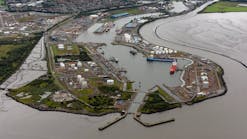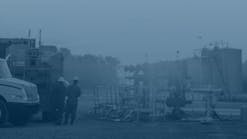Change is sweeping South America's petroleum industry.
In each of the continent's major oil and gas producing countries, efforts are under way to boost activity in all petroleum sectors.
It is part of a wave of change involving democratization, privatization, economic reform, and pursuit of free market principles that began in earnest in South America during the 1980s.
Moreover, South America's rapidly changing petroleum industry is the vanguard for similar changes likely to spread throughout Latin America and the Caribbean Sea.
State oil companies are being buffeted by reform and restructuring, often clashing with government leaders, as they seek to exploit a massive indigenous petroleum resource second only to the Middle East. Most of these countries look to their petroleum sectors as the engine of economic growth in the 1990s, through revenues from exports and/or reduced outlays for imports.
Critical to that effort is the push to attract foreign participation in the form of capital and technology. Barriers are falling all over South America as new market oriented governments reform fiscal regimes and petroleum laws to improve their countries' attractiveness for foreign investment. At the same time, subsidies for domestic fuel prices, long the bane of state oil companies, are being selectively phased out to improve the state companies' bottom line.
There is a sense of urgency with all this change, not the least of which relates to fiscal crises-mainly aggravated by huge foreign debt--that has plagued many of these developing countries since the early 1980s.
Governments and state companies are eyeing hungrily the flurry of joint ventures and huge infusion of capital into the tottering economies of the U.S.S.R. and eastern Europe. There is also competition for U.S., European, and Japanese investment capital from the emerging powerhouse economies of the Pacific Rim.
Finally, the onset of the Middle East crisis caused by Iraq's blitzkrieg takeover of Kuwait has recast Latin America-and South America in particular-in the role of secure supplier of oil for consuming nations. That role was touted for the region in the early 1980s, but a lack of progress on economic reform and the collapse in oil prices largely killed it.
South America's expanding role as a key supplier of crude and products in the 1990s was highlighted by President George Bush's recent tour there. A likely key to that effort will be the Bush administration's proposal for a hemispheric free trade agreement.
Venezuela has lobbied especially hard to become the oil supplier of choice to the U.S. The other nations of South America don't have the kind of oil and gas reserves, nor the infrastructure, that could sustain exports at a level approaching Venezuela's. Those other nations would do well to sustain current levels of oil exports and/or cut oil imports while struggling to reform their economies, the current strong push notwithstanding.
Thus it is likely that Venezuela will prove a litmus test not only for South America's petroleum renaissance in the 1990s but also for the rest of Latin America. Foreign participation has been mostly taboo in Venezuela's petroleum sector, especially upstream, since the industry was nationalized in 1976. However, state oil company Petroleos de Venezuela SA is pressing foreign joint ventures not only in petrochemicals and refining but also in oil and gas exploration and production.
That should prove a healthy precedent for foreign companies seeking opportunities for oil and gas investment elsewhere in Latin America, notably Mexico, where the political barriers to foreign participation are perhaps toughest to overcome. But as Mexico faces the prospect of becoming a net oil importer in the 1990s without a huge infusion of E&D capital, the success of South America's push to open its petroleum sector to outside participation might prove too strong an argument to overcome.
That push is spreading throughout Latin America, as evinced by recent forays into nations as sparsely drilled as Belize and the Dominican Republic (OGJ, Dec. 17, 1990, pp. 29, 31).
It all adds up to Latin America in general and South America in particular providing a wealth of opportunity for the world petroleum industry in the 1990s.
LATIN AMERICAN POTENTIAL
South America accounts for most of the oil potential in Latin America. Outside of Mexico, there are no significant oil producers in the region that are not part of South America.
"Our continent has sufficient petroleum for its own consumption for at least 70 years," said Alvaro Teixeira, secretary general of the Association of Latin American State Oil Companies (Arpel). Arpel, founded in October 1965 and based in Montevideo, represents 19 state oil companies.
Arpel estimates Latin America, including the Caribbean, holds 125 billion bbl of crude reserves-about 13% of the world's total, produces about 7 million b/d of crude--about 11.7% of the world total, and consumes about 4.7 million b/d.
Latin America's crude production in first half 1990 averaged 6.7 million b/d, up 7.6% from first half 1989.
Efforts are under way to boost natural gas utilization in Latin America as well. Exploration for gas and a phaseout of gas flaring in Latin American oil operations is on the rise as those nations expand gas grids to back out liquid and solid fuels, according to Alexis Rivero, technical director of the Latin American Energy Organization (Olade).
Olade estimates Latin American/Caribbean proved gas reserves at 250.7 tcf, about 6.2% of the world total. Venezuela, Mexico, and Argentina account for 83% of the region's total reserves with 102 tcf, 74 tcf, and 26 tcf, respectively. In Brazil, where proved reserves total about 3.7 tcf, about 74 MMcfd of gas is flared in the Campos basin alone.
Latin American/Caribbean gas production in 1989 reached 11 bcfd. The region's gas demand averaged only 3.78 bcfd in the period.
REGIONAL INTEGRATION
Arpel and Olade concur that eventual integration of Latin America's energy resources is essential to the region's future economic development and would complement economic goals generally subscribed to by most nations in the region.
Teixeira, also recently named president of state owned Petroleos Brasileiro SA, contends that only an effective integration among Latin American countries can cushion the effects of an oil supply crisis such as that looming in the Persian Gulf.
Olade considers the creation of a transnational gas grid in South America's southern cone-Argentina, Bolivia, Brazil, Chile, and Uruguay-to be essential to Latin American energy integration in the 1990s. There already is some movement in that direction, involving gas pipelines between Argentina and Bolivia, sales of Bolivian gas to Brazilian power plants, and other gas supply deals in the works among Argentina, Bolivia, and Brazil.
There remain numerous obstacles to Latin American integration. One of the thorniest is accommodating wildly fluctuating different currencies.
Some governments remain on a path towards economic integration despite the problems. Brazil and Argentina in recent year have signed wide ranging agreements to form a common market by the end of 1994, equalizing currencies and eliminating trade barriers. Trade between the two has increased as a result.
In early September 1990 Paraguay and Uruguay joined a task force commissioned by the Brazilian and Argentine governments to outline the framework of a common market in the southern cone.
INTEGRATION HURDLES
Olade noted the hurdles ahead for the campaign by Latin American/Caribbean governments to reform and revitalize economies in the region.
"These approaches have been grounded in the severe questioning and reappraisal of the role of the state, greater participation by the private sector, and a lesser emphasis on economic planning as a function of market developments," Olade said.
" Even though many of the policies currently being implemented prove necessary, it is essential to recognize that this (often abrupt) return to orthodox capitalism ... is difficult for many countries, in large part due to the inertia of certain sectors, including business groups and labor unions-which are accustomed to operating in some times chaotic conditions over long periods-as well as to the structural features of the region's economies and societies."
ENERGY EFFICIENCY DECLINES
Gabriel Sanchez-Sierra, Olade's executive secretary, says that due to economic recession and other factors, energy use in Latin America and the Caribbean at the end of the decade was more inefficient than in 1980.
"To produce $1,000 of GDP now requires 2.81 bbl of oil, as opposed to the 2.76 bbl required in 1980. This trend is totally opposite to that observed in the industrialized countries," he said.
That situation has worsened since the onset of the Persian Gulf crisis, particularly among the oil importing countries. The most salient feature of the Latin American energy sector at the end of the 1980s was net energy imports totaling more than $80 billion/year.
Although the region is a net exporter of crude oil-2.68 million b/d in 1989 vs. and 2.57 million b/d in 1980-Latin American oil imports in 1989 averaged 1.01 million b/d.
Most industry projections put the highest rate of growth in oil demand among the developing nations.
A commission of the European Community's directorate general for energy noted recently the problems related to energy supply/demand bear heavily on less developed countries (LDCs).
"The growth in energy demand in the Third World, particularly in the high population LDCs in Asia and Latin America, will have a major impact on the future of the world energy and environment situation," the EC commission said. "These countries are currently facing a real energy crisis due to rapid population growth, an urgent need to increase per capita energy consumption to improve living standards, and a move from noncommercial to commercially traded fuels. Payment for their growing energy needs is particularly difficult for those countries with major debt problems."
Correspondingly, when the price of oil jumps, developing nations that are net oil importers are hit especially hard. The main fear gripping governments in Latin America today is that higher oil prices could undermine economic stabilization programs.
In Latin America, only Venezuela, Mexico, Ecuador, Argentina, Colombia, Peru, and Trinidad and Tobago are net oil exporters. The others are net importers, some struggling near self-sufficiency.
Of the region's oil exports in 1989, 75% went to the U.S., 15% to western Europe, and the rest to other areas. Latin American imports of crude and products in 1989 came mostly from the Middle East and northern Africa with some from the U.S.S.R. -for Cuba-and the U.S. Middle East imports are mainly for Brazil. Central America imports its oil mainly from Mexico and Venezuela.
REGIONAL INTERDEPENDENCE
Olade recommends that member countries become less dependent on Middle Eastern oil supplies and more dependent on oil and gas from within the region.
But industry officials note that countries such as Brazil, burdened with high debt and lacking hard currency, prefer to import crude from the Middle East because they can engage in barter deals with many Arab countries in need of goods and services.
Latin American oil exporters generally want to be paid in dollars.
Olade calculates that each dollar increase in oil export prices represents another $1.4 billion/year for the region's oil exporters. Petroleum revenues account for 80%, 70%, and 40% of export revenues in Venezuela, Mexico, and Ecuador, respectively.
On balance, however, most of the 21 member countries of Olade suffered economically from oil price hikes. Olade notes that if the price of crude is about $30/bbl, the resulting increase in trade deficit ranges from 10% in Brazil to 150% in Honduras.
For exporters and importers alike in Latin America, then, that provides sufficient incentive to attractive foreign capital and technology to a region whose full petroleum potential has yet to be tapped.
Copyright 1991 Oil & Gas Journal. All Rights Reserved.


